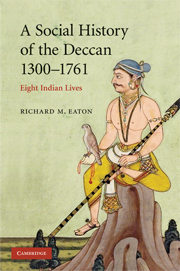Book contents
- Frontmatter
- Introduction
- 1 Pratapa Rudra (R. 1289–1323): the demise of the regional kingdom
- 2 Muhammad Gisu Daraz (1321–1422): Muslim piety and state authority
- 3 Mahmud Gawan (1411–1481): Deccanis and Westerners
- 4 Rama Raya (1484–1565): élite mobility in a Persianized world
- 5 Malik Ambar (1548–1626): the rise and fall of military slavery
- 6 Tukaram (1608–1649): non-brahmin religious movements
- 7 Papadu (fl. 1695–1710): social banditry in Mughal Telangana
- 8 Tarabai (1675–1761): the rise of Brahmins in politics
- Select bibliography
- Index
- Plate Section"
- References
2 - Muhammad Gisu Daraz (1321–1422): Muslim piety and state authority
Published online by Cambridge University Press: 28 March 2008
- Frontmatter
- Introduction
- 1 Pratapa Rudra (R. 1289–1323): the demise of the regional kingdom
- 2 Muhammad Gisu Daraz (1321–1422): Muslim piety and state authority
- 3 Mahmud Gawan (1411–1481): Deccanis and Westerners
- 4 Rama Raya (1484–1565): élite mobility in a Persianized world
- 5 Malik Ambar (1548–1626): the rise and fall of military slavery
- 6 Tukaram (1608–1649): non-brahmin religious movements
- 7 Papadu (fl. 1695–1710): social banditry in Mughal Telangana
- 8 Tarabai (1675–1761): the rise of Brahmins in politics
- Select bibliography
- Index
- Plate Section"
- References
Summary
A Deccani, on being once asked whom he considered the greater personage, the Prophet Muhammad or the Saiyid, replied, with some surprise at the question, that although the Prophet was undoubtedly a great man, yet Saiyid Muhammad Gisu-daraz was a far superior order of being.
Muhammad Qasim Firishta d. 1611)In July 1321, about the time Ulugh Khan's army was sent to Warangal to recover the unpaid tribute owed by Pratapa Rudra, an infant son was born in Delhi to a distinguished family of Saiyids – that is, men who claimed descent from the Prophet. Although he lived most of his life in Delhi, Saiyid Muhammad Husaini Gisu Daraz would become known mainly for his work in the Deccan, where he died in 1422 at the ripe age of just over a hundred years.
As seen in the extract from Firishta's history quoted above, this figure occupies a very special place in Deccani popular religion: soon after his death his tomb-shrine in Gulbarga became the most important object of Muslim devotion in the Deccan. It remains so today. He also stands out in the Muslim mystical tradition, as he was the first Indian shaikh to put his thoughts directly to writing, as opposed to having disciples record his conversations. But most importantly, Gisu Daraz contributed to the stabilization and indigenization of Indo-Muslim society and polity in the Deccan, as earlier generations of Sufi shaikhs had already done in Tughluq north India. In the broader context of Indo-Muslim thought and practice, his career helped transform the Deccan from what had been an infidel land available for plunder by north Indian dynasts, to a legally inviolable abode of peace.
Keywords
- Type
- Chapter
- Information
- A Social History of the Deccan, 1300–1761Eight Indian Lives, pp. 33 - 58Publisher: Cambridge University PressPrint publication year: 2005
References
- 2
- Cited by

